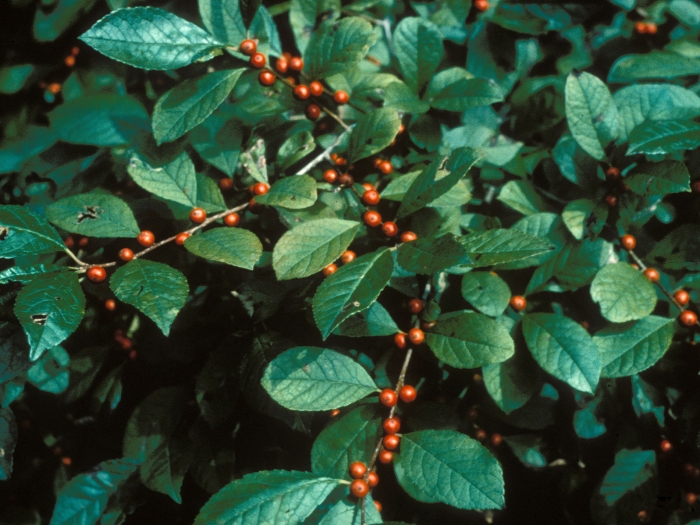Smooth Winterberry
(Ilex laevigata)
Smooth Winterberry (Ilex laevigata)
/
/

Richard Webb, Bugwood.org
CC BY 3.0
Image By:
Richard Webb, Bugwood.org
Recorded By:
Copyright:
CC BY 3.0
Copyright Notice:
Photo by: Richard Webb, Bugwood.org | License Type: CC BY 3.0 | License URL: http://creativecommons.org/publicdomain/zero/1.0/deed.en | Uploader: Nonenmac | Publisher: Wikimedia Commons |













Estimated Native Range
Summary
Ilex laevigata, commonly known as Smooth Winterberry, is a deciduous shrub native to swampy woods, wetlands, and along streams in the Eastern United States. It typically grows to a height of 3-10 feet (0.9-3 meters) and a width of 3-8 feet (0.9-2.4 meters), with a rounded form. The plant is known for its small, white to cream flowers that appear in late spring to early summer, which are not particularly showy but are attractive to pollinators. In the fall, it produces a profusion of red berries that are highly ornamental and provide food for birds.
Smooth Winterberry is valued for its adaptability to wet conditions and is often used in rain gardens, naturalized areas, or as a hedge in residential landscapes. It thrives in acidic, consistently moist to wet soils and can tolerate standing water. While it prefers full sun to part shade, it is also capable of growing in heavier shade. Smooth Winterberry is relatively low-maintenance, but it is dioecious, meaning both male and female plants are needed for fruit production. It can suffer from leaf spot and mildew, and occasionally from scale insects and spider mites.CC BY-SA 4.0
Smooth Winterberry is valued for its adaptability to wet conditions and is often used in rain gardens, naturalized areas, or as a hedge in residential landscapes. It thrives in acidic, consistently moist to wet soils and can tolerate standing water. While it prefers full sun to part shade, it is also capable of growing in heavier shade. Smooth Winterberry is relatively low-maintenance, but it is dioecious, meaning both male and female plants are needed for fruit production. It can suffer from leaf spot and mildew, and occasionally from scale insects and spider mites.CC BY-SA 4.0
Plant Description
- Plant Type: Shrub, Tree
- Height: 3-10 feet
- Width: 3-8 feet
- Growth Rate: Moderate
- Flower Color: White, Cream
- Flowering Season: Spring, Summer
- Leaf Retention: Deciduous
Growth Requirements
- Sun: Full Sun, Part Shade
- Water: Medium
- Drainage: Medium, Fast, Wet
Common Uses
Bee Garden, Bird Garden, Butterfly Garden, Deer Resistant, Low Maintenance, Rabbit Resistant
Natural Habitat
Native to swampy woods, wetlands, and along streams in the Eastern United States
Other Names
Common Names:
Scientific Names: , Ilex laevigata, Ilex laevigata f. herveyi, Prinos laevigatus, Ilex laevigata f. laevigata, Prinos laevigatus var. lanceolatus, Prinos nitidus,
GBIF Accepted Name: Ilex laevigata (Pursh) A.Gray